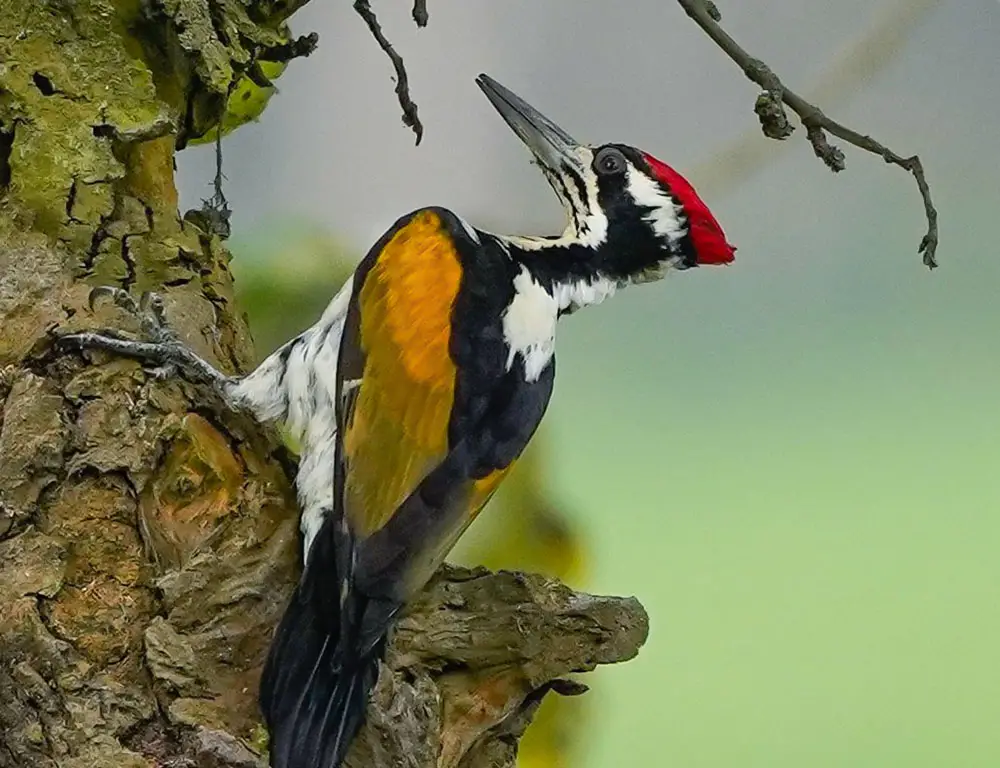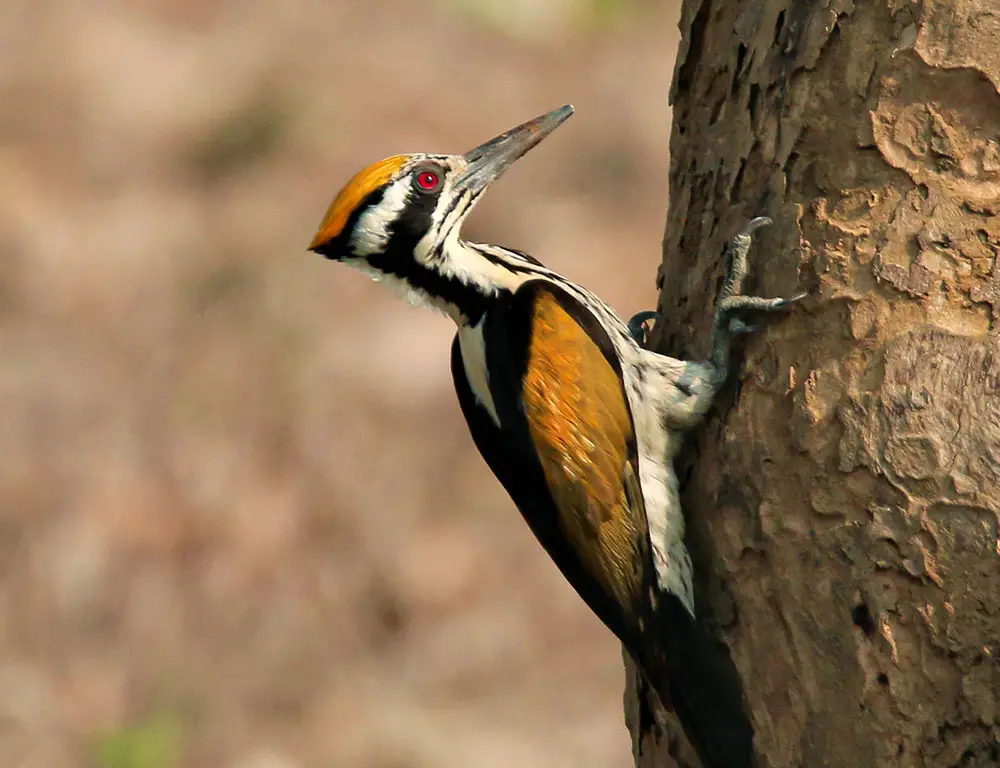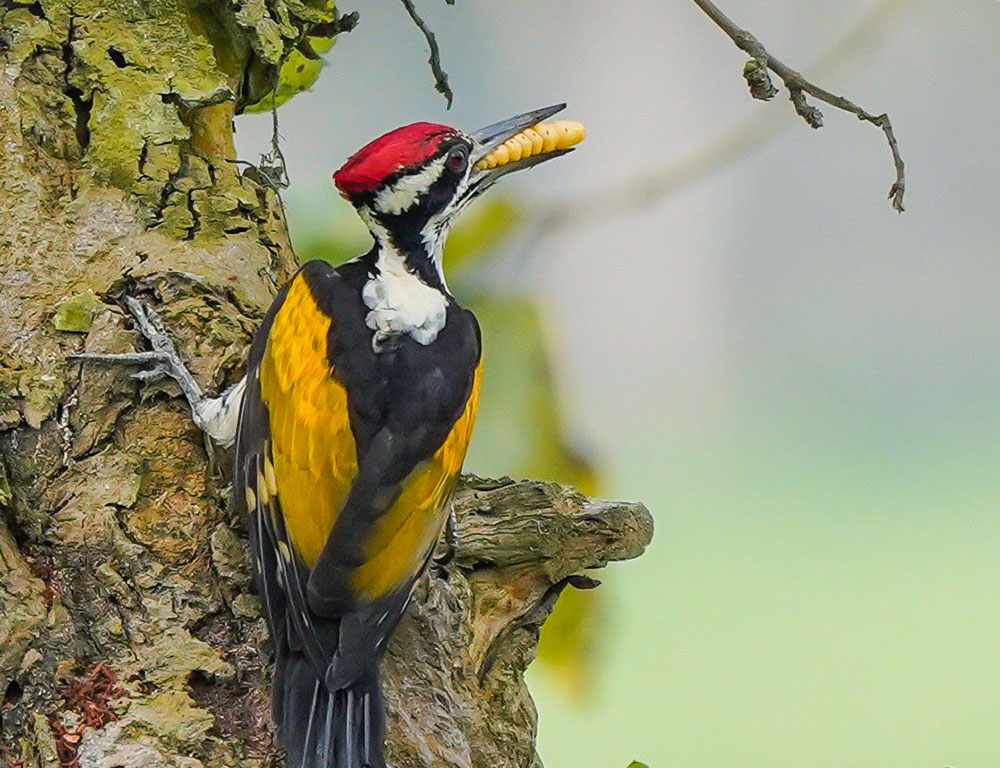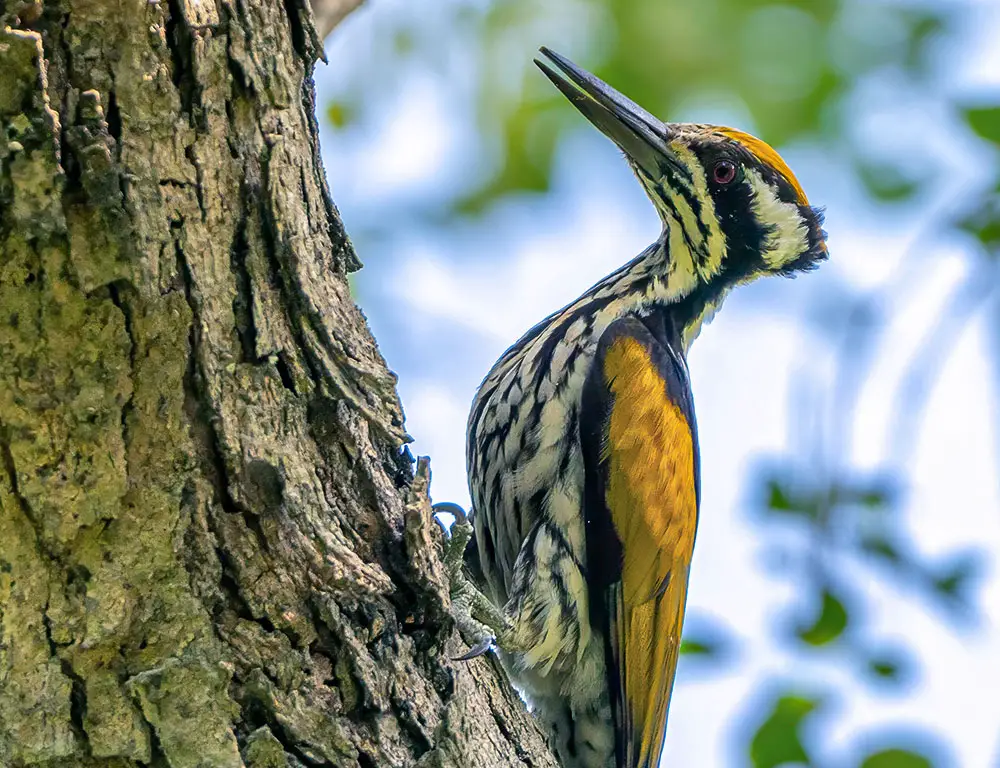Welcome to the vibrant world of avian diversity, where species like the White-Naped Woodpecker reign as captivating marvels of nature.
Native to South Asia, these birds command attention with their striking contrast of a white nape and crown against a predominantly black body.
As an enthusiast of woodpeckers, I’ve been drawn to this unique avian specimen’s intriguing habits and habitats.
Beyond their renowned tree-pecking for insects, White-Naped Woodpeckers contribute significantly to the ecosystem, serving as pest controllers and aiding in seed dispersal—a testament to the profound impact of even the smallest creatures.
Their social dynamics, including monogamous bonds and shared parental responsibilities, further add to their allure. Join me in exploring the fascinating world of the White-Naped Woodpecker, where each discovery unveils new wonders of nature’s intricacy.
Physical Characteristics of White-Naped Woodpecker

The White-Naped Woodpecker (Chrysocolaptes festivus) is characterized by a set of remarkable physical features, contributing to its distinct appearance and ecological niche:
Coloration
The bird exhibits a striking contrast, with a predominantly black body complemented by a white nape and throat. This contrast is one of its most prominent identifying features.
Size
White-Naped Woodpeckers typically measure 28-30 cm in length, categorizing them as medium-sized birds within their family.
Eye Color
Their eyes are notable for their pale yellow coloration, adding a dash of vibrancy to their overall appearance.
Beak
Possessing a sharp and robust grey-colored beak, White-Naped Woodpeckers are well-equipped for their feeding behavior, which involves pecking into tree barks in search of insects.
Wings and Tail Feathers
When spread open, the wings and tail feathers reveal an intricate pattern of dotted white spots against a black background, creating a captivating spectacle for birdwatchers.
Feet Type
White-Naped Woodpeckers feature zygodactyl feet, with two toes pointing forward and two backward. This foot structure enables them to climb tree trunks while foraging for insects hidden within the bark.
Habitat and Distribution of the White-Naped Woodpecker

The White-Naped Woodpecker (Chrysocolaptes festivus) is intricately tied to specific habitats and distributions across South Asia:
Habitat Preference
These woodpeckers thrive in deciduous and evergreen forests, particularly favoring lowland areas. They seek tall trees with suitable nesting sites, often utilizing tree hollows as roosting spots, protecting them from predators.
Geographical Distribution
The species is primarily found in several South Asian countries, including India, Sri Lanka, Nepal, Bhutan, and Bangladesh. This distribution highlights its adaptability to various climates and environments within the region.
Preferred Trees
White-Naped Woodpeckers prefer certain tree species, notably fruiting Ficus trees. This preference may be attributed to the increased availability of food these trees provide during specific times of the year.
Threats
Human activities pose significant threats to the habitat and survival of the White-Naped Woodpecker. Deforestation, driven by urbanization, agriculture, and logging, results in habitat loss, reducing the availability of suitable nesting sites and foraging grounds.
Habitat fragmentation further exacerbates the situation, isolating populations and impeding gene flow, which can lead to reduced genetic diversity and viability.
Behavior and Diet of White-Naped Woodpecker

The White-Naped Woodpecker (Chrysocolaptes festivus) exhibits distinctive behaviors and dietary preferences, contributing to its unique ecological niche:
Solitary Lifestyle
These woodpeckers are typically solitary birds, often observed alone or in pairs. They begin their day at dawn with territorial calls, establishing and defending their feeding and nesting territories.
Communication
White-Naped Woodpeckers utilize a range of vocalizations, including rattles and sharp notes, for communication with conspecifics. These calls serve various purposes, including territorial defense and mate attraction.
Dietary Habits
The primary diet of the White-Naped Woodpecker consists of insects, which comprise approximately 70% of their food intake. They specialize in foraging for insects hidden within tree bark or rotting wood, using their long, sticky tongue to extract prey from crevices.
Additionally, they consume fruits, comprising about 30% of their diet.
Nesting Behavior
White-Naped Woodpeckers are cavity nesters, utilizing dead trees or branches to create their nesting sites. They excavate cavities using their powerful beaks, constructing nests within the wood.
Breeding typically occurs during the monsoon season, with nests positioned at higher altitudes to minimize the risk of flooding.
Migratory Patterns
While not extensive migrants, White-Naped Woodpeckers may undertake short-distance movements in search of food or suitable nesting sites, particularly during specific seasons.
Conservation Status of the White-Naped Woodpecker

The conservation status of the white-naped woodpecker is currently classified as “Least Concern” by the International Union for Conservation of Nature (IUCN) Red List. This designation indicates that their population is stable and not facing immediate threats of extinction.
However, it’s essential to remain vigilant as habitat loss due to factors such as deforestation for agricultural expansion and human settlement remains a significant concern.
To protect the white-naped woodpecker and its habitat, several measures can be taken:
Enforcing strict regulations against deforestation
Governments and conservation organizations should implement and enforce laws and policies to protect forests and prevent their conversion into agricultural land or human settlements.
Raising awareness
Educating the public about the existence and importance of the white-naped woodpecker can help garner support for conservation efforts. Increased awareness can increase public participation in conservation initiatives and encourage policymakers to prioritize habitat protection.
Monitoring habitats
Regular monitoring of forests and woodland areas where the white-naped woodpecker resides is essential for identifying and addressing potential threats such as habitat degradation, illegal logging, and encroachment.
Conclusion
The White-Naped Woodpecker stands as a symbol of resilience and adaptation in its native habitats, embodying the marvels of nature with its distinctive characteristics and vital ecological role.
Despite facing threats like habitat loss, its story underscores the importance of conservation efforts. Found mainly in South Asia, this bird’s diet of insects underscores its ecological significance.
As we strive for a sustainable future, let us recognize the value of every species, including the White-Naped Woodpecker, in maintaining the delicate balance of our ecosystems.
We can ensure these remarkable creatures continue to thrive and inspire future generations through awareness, action, and appreciation. No matter how small, every creature contributes to the rich tapestry of life on Earth.